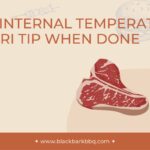We all know that we need to be careful when cooking fish. You will need to ensure that your fish reaches a certain internal temperature before it can truly be cooked.
The tricky thing with salmon is that it is so easy to keep cooking it to ensure that it is cooked all the way through, only to find that it has dried out.
Of course, there is nothing worse than a sad bit of dried out salmon. The best types of cooked salmon are of course juicy but properly cooked. But how come it tends to dry out when you try to ensure it has been thoroughly cooked?
The answer is more obvious than you think. Most cuts of salmon tend to dry out during the cooking process because they have been overcooked.

Even though some experts would recommend cooking your salmon so that it reaches an internal temperature of 145℉, this isn’t recommended for getting the juicy salmon that you are after.
Instead, you should cook your salmon so that it reaches an internal temperature of between 120℉ to 125℉. To ensure that your salmon has reached the proper temperature when you cook it, it will be best to use a thermometer probe designed with cooking in mind.
No matter how much you would like to, you can’t tell whether your salmon has finished cooking just by looking at it. Using a digital thermometer is the best way to see whether your salmon is done cooking, or whether it needs a little bit longer.
Today, we’re going to cover everything you need to know about cooking different types of salmon, and what internal temperature they need to reach before they are done. So let’s take a look at everything you need to know!
The Recommended Methods For Cooking Different Salmon Types
Now it may be simple to think that one rule applies to each type of salmon. However, this isn’t the case.
There are several different types of salmon that you can find at your local grocery store, and different cooking temperatures will apply to each. This is all down to something as simple as differing fat contents.
The most popular types of salmon that people like to cook are Atlantic farmed salmon, red salmon, chinook salmon, and blue jack salmon.
We’re going to cover each type of salmon in a little more detail so that you will have a better idea of what internal temperature each variety needs to reach before it has finished cooking.
Atlantic Farmed Salmon
Because it is sustainably sourced, Atlantic farmed salmon tends to be the most popular variety of salmon that is consumed across America.
Unlike the wild varieties of salmon, Atlantic farmed salmon tends to have a higher fat content. This is of course because they are farmed in ocean pens, where they have ready access to food sources.
Red Salmon
Red salmon gets its name from the fact that its flesh tends to be a deep red, especially when compared to other varieties of salmon such as chinook and blue jack.
Red salmon is highly flavorful, with a much lower fat content than chinook salmon. However, this variety of salmon tends to dry out quicker if it hasn’t been cooked properly.
Chinook Salmon
This is arguably the largest variety of salmon that can be found around the world, which has earned it the synonym king salmon.
Chinook salmon can reach some impressive sizes when they reach full maturity. This species of salmon also has a higher fat content, which means it is best suited to either pan-fried dishes or roasted dishes.
Blue Jack Salmon
One of the smaller varieties of salmon that is available at your local grocery store, blue jack salmon tends to pack a flavorful punch.
This variety of salmon is perfectly suited to methods that require curing because it is smaller and easier to slice as a result. Blue jack salmon has a much lower fat content.
What Is The Best Temperature To Use For Cooking Salmon?
So now that we know a little bit more about the most popular species of salmon that can be used for cooking, we can now take a closer look at which method of cooking we can use.
It’s important to note that each cooking method will require different temperatures to reach the correct stage of done-ness.
Even though it may be tempting to opt for a larger heat so that your salmon will be cooked quicker, we would advise against doing this.
If you choose a hotter temperature, your salmon will dry out quicker. The best temperature to use for cooking salmon is around 325℉. This is a good middle ground for the vast array of cooking methods.
The cooking methods that we cover in more detail below are considering a salmon filet that is between 6 to 8 ounces. If you are cooking an entire salmon, then you will need to stick with the lower cooking temperature of around 325℉.
This is because anything hotter than this, and parts of the salmon will become too dry to be enjoyable.
Of course, the length of time that you cook your whole salmon will depend on its size. Again, this is where a digital meat thermometer will come in handy.
By opting for a probe model, you can stick the probe into your salmon, and safely measure when it has reached 125℉.
With that being said, let’s take a closer look at the best cooking methods to use for cooking your salmon filet!
The Oven Roasting Method
One of the best methods to use for cooking your salmon filet is of course to roast it in your oven. First things first, you will need to preheat your oven to around 500℉.
Next, you can prepare your salmon filet. Using a sharp knife, make incisions along the skin of your salmon filet between 3 to 4 times. Avoid cutting into the flesh of the filet if you can.
Use a paper towel to pat your fish filet dry of any added moisture. Then you can start to rub some olive oil over the filet, and add a dash of pepper and salt to season it. Place your now prepared salmon filet onto a baking sheet with a rim, with the skin side facing down.
Lower the heat of your oven to around 325℉, then place your baking sheet complete with the prepared salmon inside. Make sure to oven roast your fish until it reaches around 120℉ on your digital thermometer probe.
It will take between 8 to 12 minutes for this to happen. Allow your salmon filet to rest for around 5 mins, then serve it with your favorite side dishes.
The Water Bath Method
One of the more interesting cooking methods that we have covered, the water bath method is perfect for those who want a no-fuss, no-mess cooking option for their salmon.
This will involve placing your salmon filet into a sealable freezer bag, along with any seasonings you wish to use.
Before you get started, you will need to preheat the water bath to around 125℉. When it has reached the ideal temperature, you can then dip the bagged salmon into the hot water. It may be best to use ziplock bags or something similar so that the water can’t get in.
Allow your salmon to cook in the water bath for around 20 minutes, or until the flesh has become opaque. You can then serve your salmon filet with your preferred side dishes.
The Pan Frying Method
To get some excellent tasty flavors from your salmon filet, you can of course pan fry it. Below is the best method to use for pan-frying your salmon filet.
Using your favorite cast iron skillet, heat a little olive oil or vegetable oil over medium to high heat. Make sure to put your salmon filet in the skillet with its skin facing downwards, you can then pan fry it until the salmon skin has started to become crispy.
You’ll know your salmon filet is ready when it moves around easily when you gently poke it with your fish spatula. It should take between 3 to 5 minutes for your salmon to finish cooking properly.
Once the filet has started moving around freely when you touch it with your fish spatula, you can then flip it. Allow your fish to cook this side for around 2 to 4 minutes.
Remove your cooked salmon from your cast iron skillet, then allow it to rest for around 5 mins.
The Grilling Method
Perhaps one of the healthiest methods for cooking your salmon, the grilling method is super easy to use. It also gives it a classic smoky flavor if you choose to use smoking woods during the cooking process.
To get the best results from grilling your salmon, you will need to start a two-zone fire. This will mean putting 1 or 2 propane burners on a high setting, and cooking your salmon filet with its skin side facing downwards on the hottest section of the propane grill.
Put your grill cover in place, then allow your salmon to cook for around 3 mins.
If you tend to use a charcoal grill instead of a propane grill, then you will need to light your briquets in the chimney section.
Place around three-quarters of these now-lit briquets towards one side of the grill once they are ready to be used. The same method then applies; place your salmon filet with its skin side facing down on the hottest part of the grill for around 3 mins.
After the 3 minutes have elapsed, you can then test to see if the filet can be removed from the grill without too much hassle.
Once you have been able to successfully remove it from the grill without it sticking, make sure to flip your salmon filet so that you can cook it flesh side down for a couple of extra minutes.
Remove your salmon filet from the grill, and allow it to rest for around 5 mins, then it will be ready to serve.
Final Thoughts
And there you have it! You now know all there is to know about cooking your salmon efficiently. There are so many different methods for you to use, and you now know which ones will be the best for you and your favorite fish filet.
No matter which variety of salmon you like to use, you know how to approach their ideal cooking methods.
If in doubt, it will be best to use a digital meat thermometer to help you. This should tell you when the salmon has reached an internal temperature of 120℉, which will ensure that your salmon is cooked perfectly.
- Porterhouse Vs. Ribeye - May 16, 2022
- How Long To Smoke A Brisket Per Pound – Explained - May 16, 2022
- What Is A Tomahawk Steak? - May 16, 2022








